Abstract
This study aims to overcome the technical bottleneck of non-invasive differentiation between the rammed earth layer and pebble layer in complex shallow subsurface environments, particularly focusing on the challenge of detecting highly heterogeneous pebble layers with complex wavefield characteristics. Using the western city wall of the Baodun site (Xinjin, Sichuan, China) as a case study, we introduce a high-resolution seismic detection technique combined with controllable high-frequency seismic source excitation to investigate the response characteristics of high-frequency components and energy variations of seismic waves in different strata, thereby revealing differences in physical properties between the rammed earth layer and pebble layer. Through high-frequency data acquisition, specialized processing, and interpretative analysis of seismic data, we successfully distinguish the two strata and delineate pebble-related anomalous zones. The results also indicate that, due to complex geological conditions, the reflection and refraction patterns of seismic waves in the pebble layer are exceptionally intricate. Moreover, the interplay of abrupt seismic velocity variations, interference waves, and other contributing factors leads to pronounced heterogeneity and strong scattering characteristics in the seismic data across the time, frequency, and phase domains. This research overcomes the limitations of conventional geophysical methods and confirms the applicability of high-frequency seismic techniques to complex near-surface archaeological contexts. It provides robust scientific support for the archaeological study of the Baodun site and offers a methodological reference for subsurface mapping of pebble layer in prehistoric urban landscapes.
1. Introduction
The construction of Chinese city walls has a long history. Their forms and functions have been fundamentally shaped by geographical constraints and the evolving demands of different historical periods. Since the 1990s, eight late Neolithic city sites have been discovered and excavated on the Chengdu Plain, including the Baodun site in Xinjin [1,2,3], the Gucheng site in Pixian [4,5], the Yufu site in Wenjiang [6], the Mangcheng site in Dujiangyan [7,8,9], the Shuanghe site in Chongzhou [10], the Zizhu site [11], the Yandian site in Dayi [12], and the Gaoshan site [13]. Collectively, these sites constitute the core cultural remains of Baodun culture [14], dating back approximately 4500–3700 years (detailed information on the relevant archaeological sites is provided in Table 1). City wall structures at these sites (detailed information on the construction techniques of the city wall is provided in Table 2) not only served essential functions such as flood control and settlement defense but also demonstrated the engineering ingenuity of ancient inhabitants through the use of distinctive pebble-layer construction techniques [15]. Archaeological investigations have revealed that the pebble layer was extensively employed in the construction of city walls, ash pits, hydraulic infrastructure, and foundation trenches. It primarily served to enhance structural stability through the mixture of sand and gravel, while also functioning as an effective drainage system designed to mitigate the impacts of flooding and water infiltration [16] (the functions of the pebble layer and related data are presented in Table 3). Excavations at the western city wall trench of the Baodun site in Xinjin revealed multiple rammed earth strata (Q2, Q3, Q1a, Q1b, and Q2a) [17] (an interpretation of the Q layer is presented in Table 4), with a densely distributed pebble layer throughout. This further confirms the Baodun culture’s city-building philosophy and the construction model of “adapting to local conditions.” However, identifying the pebble layer through geophysical methods poses significant technical challenges due to their internal heterogeneity and complex geological composition. The anomalous propagation of seismic waves through pebble-rich zones complicates the accurate delineation of internal wall structures and subsurface archaeological features [18]. Therefore, mapping the distribution and structural characteristics of the pebble layer is crucial for reconstructing ancient construction techniques, interpreting the spatial layout of subsurface remains, and enhancing the precision of geophysical prospecting.

Table 1.
Excavation Information, Cultural Affiliation, and Heritage Status of Baodun Culture Sites in the Chengdu Plain.

Table 2.
Summary of City Wall Forms, Dimensions, and Construction Methods at Neolithic Sites in the Chengdu Plain.

Table 3.
Summary of Pebble Features and Their Archaeological Interpretations at Neolithic City Sites in the Chengdu Plain.

Table 4.
Stratigraphic Characteristics of the City Wall at Baodun Site, Xinjin.
In recent years, the deep integration of modern technology with traditional archaeology has fostered a multidimensional technical system in China centered around integrated aerial–space–ground detection, significantly improving both the accuracy and non-invasiveness of archaeological investigations. Remote sensing and Geographic Information Systems (GIS) have been widely applied for the extraction and analysis of spatial data [19,20,21,22,23]. High-resolution Digital Elevation Models (DEMs), derived from satellite imagery [24], unmanned aerial vehicle (UAV) surveys [25], and LiDAR scanning [26], have played a key role in analyzing site topography and layouts, as seen in studies of Liangzhu cultural landscapes [27] and the Sanxingdui sacrificial pits [28]. Three-dimensional laser scanning has also been widely used for detailed reconstructions of large-scale sites such as the Terracotta Army [29], enabling the precise documentation of fingerprints and tool marks on terracotta figures [30,31], and contributing to studies on standardized production methods in the Qin Dynasty. Simultaneously, microstratigraphy [32], chemical spectrometry, radiocarbon dating [33], as well as techniques such as polarized light microscopy [34], scanning electron microscopy (SEM) [35], X-ray fluorescence (XRF) [36], and inductively coupled plasma mass spectrometry (ICP-MS) [37,38] have become essential in reconstructing ancient agricultural practices and social organization. For example, the emergence of a rice-based agricultural system in the Baodun culture [39], and the identification of labor division systems at the Zhouyuan site [40] both benefited from this interdisciplinary approach.
Geophysical technologies are becoming key non-invasive tools in archaeological research in China. Ground-Penetrating Radar (GPR), electrical resistivity tomography (ERT), seismic refraction tomography (SRT), and induced polarization (IP) have shown significant success in identifying city wall foundations and underground structures at sites such as the Qicheng site, the Baling Mausoleum, and the ancient Great Wall of Linhai [41,42,43]. Additionally, digital technologies—including three-dimensional WebGIS platforms [44], low-altitude remote sensing [45], and multi-view photogrammetric modeling [46]—have been extensively adopted for site mapping and archaeological data management, advancing archaeological work toward greater systematization, precision, and visualization. Internationally, similar approaches have yielded significant results. At Egypt’s Giza and Saqqara necropolises, the combined use of seismic refraction tomography [47], GPR [48], and ERT [49] has allowed for non-invasive mapping of subsurface tomb structures, avoiding destructive excavation [50]. In Austria, the Prigglitz-Gasteil site employed a combination of seismic refraction, ERT, and drilling to reconstruct the 3D structure of a Bronze Age mining complex [51]. At the Selinunte site in Sicily, Multi-channel Analysis of Surface Waves (MASW) and ambient noise array methods were used to model near-surface velocity fields [52]. In Belize, the internal structure of a Maya pyramid was successfully imaged using integrated GPR and seismic tomography [53]. These cases collectively highlight the critical role of multi-method geophysical integration in archaeological prospection and site reconstruction.
Despite these advances, significant limitations remain when applying current methods to highly heterogeneous geological media such as the pebble layer [54,55,56]. For example, while GPR offers high spatial resolution, its effectiveness is greatly reduced in moist, coarse-grained, and pebble-rich media. In such environments, electromagnetic waves undergo strong scattering and attenuation, resulting in poor penetration and cluttered radargrams that obscure internal structures [57]. Meanwhile, although ERT can delineate large-scale stratigraphic interfaces, it has limited sensitivity and resolution for detecting a pebble layer with irregular thickness and low contrast in physical properties, often failing to resolve centimeter-scale features [58]. These challenges are further amplified in archaeological contexts with multi-period cultural deposits, severe modern disturbances, and pronounced near-surface heterogeneity, where conventional methods often suffer from ambiguous interpretations, low spatial accuracy, and poorly defined stratigraphic boundaries [59,60].
To address these limitations, this study applies high-resolution seismic detection to the western city wall of the Baodun site in Xinjin, Sichuan, China—marking the first application of such methods at this site. Using controllable high-frequency seismic sources, the internal structure of the wall, including the rammed earth and pebble layer, is systematically investigated. By analyzing frequency components and energy attenuation patterns across stratigraphic units, the study mitigates the impact of scattering and attenuation caused by heterogeneous deposits. Under strictly non-invasive conditions, anomalous zones corresponding to the pebble layer are successfully delineated, and their complex wavefield behavior is analyzed in time, frequency, and phase domains. The results provide a sound empirical foundation for reconstructing the wall’s construction techniques and development, while demonstrating the feasibility of high-resolution seismic approaches for imaging fine-scale structures in challenging archaeological contexts. This work offers valuable insights into the spatial configuration of buried remains and contributes to advancing geophysical techniques for the investigation of prehistoric walled settlements in China.
2. Materials and Methods
2.1. Regional Overview
The Baodun site is located in Baodun Village, Baodun Town, Xinjin District, Chengdu, Sichuan Province, China, covering an area of approximately 600,000 square meters. The site is situated at geographic coordinates 103°45′ E and 30°26′ N, with an elevation ranging from 472 to 474 m above sea level. Topographically, the terrain slopes gently from northwest to southeast, with the Xi River located approximately 4 km to the northeast and the Tiexi River about 500 m to the southwest (Figure 1). The region falls within the humid subtropical monsoon climatic zone, characterized by a moist environment, abundant precipitation, and relatively limited sunshine throughout the year [61].
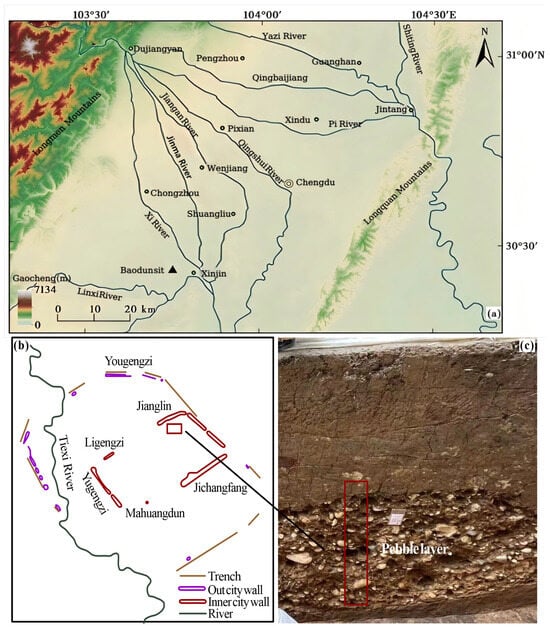
Figure 1.
Location of the Baodun Site and Photograph of the Pebble Layer. (a) Location of the site; (b) Profile location of the study area; (c) Photograph of the pebble layer.
The architectural layout of the Baodun city walls can be categorized into three types: square or near-square double-layered walls; regular rectangular walls; and irregularly shaped enclosures (Figure 2) [62]. The construction technique employed is the ramped-fill method, a widely used approach for wall-building in the Yangtze River basin during the same cultural period. This method includes two primary compaction techniques: horizontal tamping and inclined tamping (Figure 3). During construction, earth was first compacted at the central axis of the wall to form the main structural core. Once a certain height was achieved, ramped fills were added from both sides to reinforce overall stability. On the interior side, the ramped layer was more numerous and gently sloped to enhance the load-bearing capacity and facilitate movement atop the wall. In contrast, the exterior side featured fewer, more steeply angled layers, designed to improve defensive capabilities and reduce the impact of external erosion.
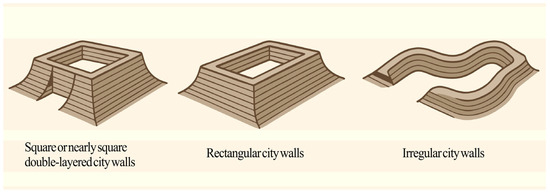
Figure 2.
Schematic Diagram of City Wall Layout Types at the Baodun Site.
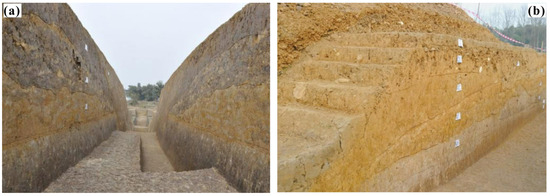
Figure 3.
Ramp-style construction methods of city walls during the same period in the Yangtze River Basin: (a) Horizontal tamping method as observed on a city wall; (b) Inclined tamping method as observed on a city wall.
The study area is located on both the interior and exterior sides of the western city wall at the Baodun site. The archaeological trench measures approximately 46 m in length and 2 m in width. Excavation results indicate that the wall segment within this trench is primarily composed of rammed earth and pebble layers, exhibiting clear stratification. The rammed earth layer accounts for approximately 60% to 80% of the wall composition, with individual layer thicknesses ranging from 0.1 to 1.7 m. The pebble layer constitutes about 20% to 40%, with thicknesses between 0.1 and 1.4 m. Within the pebble layer, pebble content ranges from 15% to 35%, predominantly consisting of sub-rounded gravel with diameters between 2 and 5 cm, with occasional clasts reaching up to 20 cm. The overall weathering degree is mild to moderate. The parent rock is primarily composed of siliceous and quartzite lithologies, with minor inclusions of limestone and sandstone. Fine sand fills the interstitial spaces between the clasts, resulting in a compact overall structure. In terms of spatial distribution, the stratigraphy of the city wall varies significantly between the interior and exterior sides. The interior profile reveals a more complex composition, characterized by multiple thin stratified layers and a typical grayish-brown pebble layer. A particularly notable feature is a row of neatly arranged pebbles uncovered at the corner of the wall, extending longitudinally along its axis. Although the full extent of this structure remains uncertain, it reaches a height of approximately 50 cm and may indicate a deliberate design element for structural reinforcement or drainage. In contrast, the exterior profile displays a relatively uniform and stable stratigraphic sequence. The basal boundary of the yellowish-brown pebble layer is clearly defined, and the interface between the rammed earth and pebble strata is sharply delineated, reflecting an orderly and intentional construction process (Figure 4).
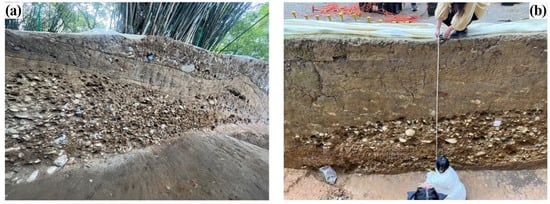
Figure 4.
Stratigraphic profiles of the interior and exterior sides of the western city wall at the Baodun site. (a) Interior profile showing multiple thin sedimentary layers and a distinct grayish-brown pebble layer. (b) Exterior profile showing clear horizontal stratification and a sharply defined interface between the rammed earth and yellowish-brown pebble layer.
2.2. Analysis of Acquired Seismic Data
The study area of the western city wall is characterized by dense vegetation and complex terrain. These environmental factors, coupled with disturbances from ongoing archaeological activities, present significant challenges to seismic prospecting. Variations in terrain and ground cover, along with anthropogenic interference, result in poor source excitation and receiver coupling conditions, which in turn lead to pronounced heterogeneity in the energy, frequency, and phase characteristics of the acquired seismic signals. Furthermore, strong surface wave energy and its pronounced dispersive effects hinder the clear identification of coherent reflection events. The interference from surface waves, refracted waves, and multiples further increases wavefield complexity, masking valid reflections and weakening effective signals. Consequently, the signal-to-noise ratio of the seismic profiles is significantly reduced, posing major challenges for subsequent data processing and geological interpretation.
2.3. Seismic Geological Method
In the pebble layer zone of the western city wall at the Baodun site, fundamental research has revealed that the high-frequency components of seismic waves exhibit anomalously active behavior. To enhance the capture of these high-frequency harmonic signals, we optimized the source excitation and receiver deployment strategies based on the geological context (Figure 5; detailed equipment parameters are listed in Table 5). Two high-density seismic acquisition configurations were employed: a bilateral excitation system, in which shot points were symmetrically placed on both sides of the geophone array with a spacing of 40 cm; and a unilateral excitation system, where shot points were positioned on only one side of the array using the same geophone spacing. The bilateral setup offers more comprehensive subsurface wavefield coverage and improves lateral resolution, while the unilateral configuration is more efficient for field deployment and better suited to areas with linear obstacles. Selection between the two approaches can be flexibly adapted to site-specific geological conditions and survey objectives. Although high-frequency seismic energy attenuates rapidly near the surface, its narrow time window allows a relatively high proportion of harmonic energy to be preserved in the seismic records, enabling high-resolution detection and delineation of the pebble layer.
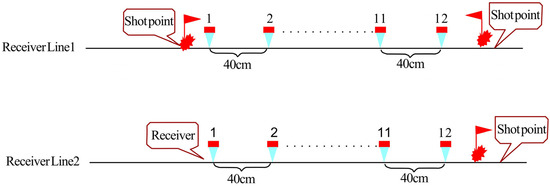
Figure 5.
Layouts of two high-density seismic acquisition systems.

Table 5.
Key Technical Specifications of the Acquisition Equipment.
In response to the distinctive reaction of the pebble layer to the high-frequency components of seismic waves [63], controllable seismic sources with low energy and high frequency were employed to enhance the signal-to-noise ratio and energy density of the high-frequency components. By increasing the number of single-point stacking iterations to several hundred, the loss of high-frequency components was effectively reduced, thereby ensuring the integrity of the high-frequency components and enhancing the clarity of the seismic signals.
Based on Fourier transform and filter design, frequency-domain filtering was applied to the input seismic data. An Ormsby filter was used to extract or suppress signals within specific frequency ranges [64]. By adjusting the filter parameters, high-frequency components were selectively extracted, and large-scale data stacking under consistent phase conditions was employed to reduce the width of seismic wave peaks. High-resolution deconvolution [65], phase correction, and other specialized processing and interpretive techniques were further employed to achieve high-resolution seismic detection.
2.4. Technical Difficulties of High-Resolution Seismic Detection
- (1)
- The excitation and reception conditions are relatively poor. The compacted rammed layer exhibits strong seismic wave absorption and attenuation, while the pebble layer produces pronounced scattering effects. Given the distinctive response of the pebble layer to the high-frequency components of seismic waves, how to effectively utilize controllable seismic sources with low energy and high frequency to enhance the signal-to-noise ratio and energy density of high-frequency components, and how to increase the number of single-point stacking iterations to several hundred in order to mitigate the loss of high-frequency energy remain key challenges in seismic data acquisition and processing.
- (2)
- The interpretation of two-dimensional seismic data presents significant challenges. The pebble layer is thin, closely spaced, and exhibits a relatively steep dip angle. Increasing the amount of energy transmitted downward, broadening the frequency bandwidth, and enhancing data resolution remain critical objectives in seismic data processing.
- (3)
- The survey area is characterized by highly active interference waves, which not only exhibit strong energy but also display complex propagation characteristics. Influenced by multiple factors—particularly refracted waves, diffracted waves, and surface waves [66]—the seismic data demonstrate significant heterogeneity and scattering in terms of energy, frequency, and phase. Therefore, under the premise of amplitude preservation and waveform fidelity, a key technical challenge lies in eliminating frequency variations and energy attenuation caused by surface conditions, source energy, and receiver performance [67], while implementing effective frequency decomposition to enhance the detectability of the pebble layer at subsurface reflection interfaces [68].
2.5. Two-Dimensional Seismic Data Processing
By analyzing the wavefield distribution along with the types and characteristics of interference waves in the raw seismic data, the frequency, phase, and energy attributes of the pebble reflection layer can be effectively extracted. As seismic waves propagate through geologically complex subsurface media, they are influenced by stratigraphic structures, lithological heterogeneities, and various other geological factors. Wavefield analysis enables the preliminary identification of the approximate location and geometric morphology of stratigraphic interfaces, thereby providing a robust foundation for the subsequent accurate extraction of reflection layer characteristics [69].
During seismic data acquisition, various types of interference waves frequently contaminate the recorded signals, including surface waves, linear noise, acoustic waves, as well as impulsive spikes and outliers induced by environmental factors such as wind and vegetation movement. These interference components can obscure or distort the true seismic reflections, thereby hindering the accurate identification of the pebble reflection layer. Consequently, in the data processing stage, it is essential to apply filtering, denoising, and other signal enhancement techniques to effectively suppress noise and improve the signal-to-noise ratio [70].
In the extraction of pebble reflector characteristics, two key attributes are of primary analytical focus: frequency and energy. Frequency characteristics reflect the seismic wave propagation velocity and the physical properties of the subsurface medium, offering critical insights into lithological composition and structural configuration. In contrast, energy characteristics represent the distribution of seismic wave energy as it travels through the medium, providing valuable information on stratigraphic continuity and potential anomalies.
2.5.1. Frequency Division
The frequency decomposition method is fundamentally based on Fourier transform principles and filter design, whereby frequency-domain filtering is applied to seismic input data. An Ormsby filter is typically employed to isolate or suppress signals within specified frequency bands. By adjusting the filter parameters, information pertaining to different stratigraphic units or structural features can be selectively extracted. However, the effectiveness of this method is influenced by various factors, including the filter design, signal-to-noise ratio, and data sampling rate [71,72,73]. Therefore, in practical applications, the selection of appropriate decomposition techniques and parameter settings must be tailored to the specific geological and acquisition conditions to ensure accurate and reliable results.
The frequency decomposition method of seismic waves was employed to separate the frequency characteristics of the rammed earth layer from those of the pebble layer. The rammed earth layer typically exhibits a relatively uniform texture and higher density, which gives rise to relatively stable frequency characteristics in the reflected seismic waves. Due to variations in the size, shape, and arrangement of the pebble particles, the physical properties and seismic responses of the pebble layer also differ accordingly, resulting in relatively high-frequency responses during seismic wave reflection. The specific frequency range may vary depending on the geological conditions and the characteristics of the pebble layer.
2.5.2. Energy Curve
The extraction of energy curves for the rammed earth layer and the pebble layer is primarily based on dividing the seismic data into multiple time windows, determined by predefined window lengths and sliding step sizes. By applying the short-time Fourier transform (STFT), amplitude spectra are generated for each time-window position. The peak amplitude of each spectrum is taken as a proxy for seismic energy within that window, thereby capturing the temporal variation of seismic energy [74,75]. This approach supports both single-trace analysis and time-window-based rectangular picking, enabling the construction of energy variation curves at both the trace level and across the entire dataset. Moreover, energy variation curves from multiple shot gathers can be stacked and compared at corresponding time-window positions to enhance interpretability (Figure 6).
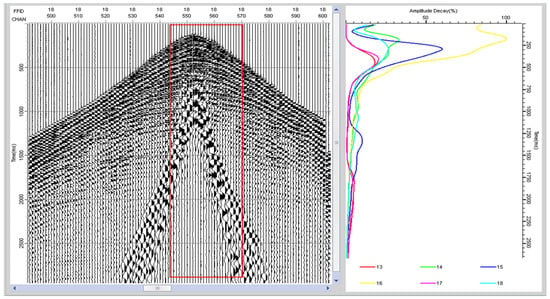
Figure 6.
Superimposed Energy Time-Varying Curves of Multi-Shot Data within the Same Time Window.
3. Results
The frequency decomposition method of seismic waves was employed to separate the frequency characteristics of the rammed earth layer from those of the pebble layer. The rammed earth layer typically exhibits a relatively uniform texture and higher density, which gives rise to relatively stable frequency characteristics in the reflected seismic waves. Due to variations in the size, shape, and arrangement of pebble particles, the physical properties and seismic responses of the pebble layer also differ accordingly, resulting in relatively high-frequency responses during seismic wave reflection. The specific frequency range may vary depending on the geological conditions and the characteristics of the pebble layer.
The energy curves of the rammed earth layer and the cobble layer exhibit clear distinctions in the frequency domain. The rammed earth layer is predominantly associated with low-frequency energy, while the cobble layer demonstrates a significant high-frequency response. These spectral differences reflect the contrasting ways in which the two strata influence seismic wave propagation. The compact and homogeneous structure of the rammed earth layer mainly facilitates the transmission of low-frequency seismic waves. In contrast, the multiple scattering effects among particles within the cobble layer more strongly affect the propagation of high-frequency components.
3.1. Frequency Division Results
Figure 7 displays multiple periodic signals across different channels, representing the propagation of seismic waves through the subsurface during geophysical exploration. To enhance the interpretation of subsurface structural information encoded in these signals, a series of processing techniques—namely periodic signal segmentation, positional alignment, and stacking—were applied. These procedures ultimately yielded the processed seismic wave stacking data.
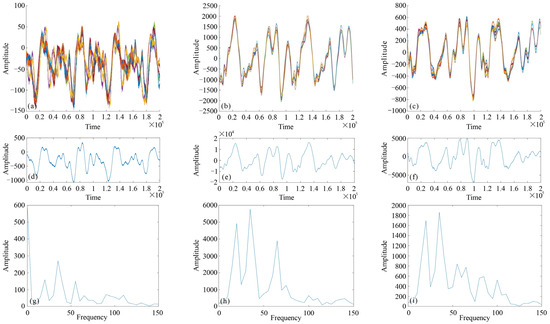
Figure 7.
Seismic waves stacking data and corresponding frequency spectra. (a–c) show the periodic signals after cross-correlation processing in Channels 1, 2, and 3, respectively. (d–f) present the stacked seismic waveforms obtained by superimposing the periodic signals shown in (a–c). (g–i) display the frequency spectra corresponding to the stacked data in (d–f), respectively.
First, the periodic segmentation of raw seismic wave signals constitutes a critical initial step in the data processing workflow. As seismic waves propagate through the subsurface, they undergo reflection, refraction, and scattering due to variations in media properties and structural interfaces, resulting in complex waveforms with periodic characteristics. By applying refined segmentation techniques, these signals can be classified based on their periodicity, enabling the extraction of key signal features across multiple frequency bands.
Next, the segmented signals undergo positional alignment, during which their cross-correlation is computed. By aligning signals from different temporal segments or spatial locations to a common reference point, coherent stacking can be effectively performed. This procedure enhances the energy of coherent signal components while suppressing random noise, thereby improving the overall signal-to-noise ratio (SNR).
As a result of this processing, the stacked seismic wave data presented in Figure 7 were obtained. The figure clearly demonstrates a significant improvement in the signal-to-noise ratio (SNR) following the stacking procedure, with the effective signals appearing more prominent and distinguishable.
The results of the spectral analysis indicate that the stacked seismic wave data contain rich dominant frequency information, reflecting the existence of multiple subsurface layers. Variations in seismic wave absorption and reflection characteristics among different strata result in distinct dominant frequency features within the spectrum. By analyzing these components, it is possible to infer and interpret subsurface stratigraphy, layer thicknesses, and lithological variations.
Figure 8 presents the results of the frequency decomposition applied to the stacked seismic data. The analysis across different frequency bands reveals clear distinctions in the frequency-domain responses of various subsurface strata. Specifically, the dominant frequency of the rammed earth layer is concentrated in the low-frequency range of 0–25 Hz, within which it exhibits a particularly strong response. This behavior likely reflects the combined effects of the rammed earth’s material composition, density, and structural characteristics, which enhance its interaction with low-frequency seismic waves. In contrast, the pebble layer exhibits a dominant frequency response within the high-frequency range of 75–105 Hz. Its enhanced sensitivity in this range may be attributed to factors such as grain size distribution, particle arrangement, and pore structure. Comparative analysis with ground-truth stratigraphic data indicates that the frequency decomposition results are relatively accurate. These results not only delineate the dominant frequency bands associated with different subsurface layers but also offer more comprehensive and nuanced insights into subsurface structures. Such findings have significant implications for geological exploration, resource assessment, and engineering applications.
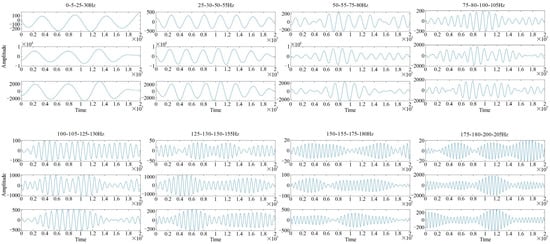
Figure 8.
Frequency decomposition results of the stacked seismic wave data derived from multiple periodic signals in Channels 1, 2, and 3, shown across different frequency bands.
Figure 9 shows the correlation between different seismic traces at a consistent scale. A higher peak value indicates a stronger correlation between traces within the corresponding frequency band. The eight peaks shown represent the correlation analysis results derived from the eight frequency bands previously presented in Figure 8, highlighting the close correspondence between the two datasets. The detailed analysis of Figure 9a–c shows the correlation behavior of trace pairs 1–2, 2–3, and 1–3, respectively, across the various frequency bands. Notably, the first frequency band (0–5–25–30 Hz) and the fourth frequency band (75–80–100–105 Hz) exhibit particularly strong correlation characteristics. In these bands, the correlation values are relatively high—approaching 1—indicating a high degree of consistency in the signal properties between the respective trace pairs.

Figure 9.
Correlation analysis between different channels at a consistent scale. (a) Correlation between Channels 1 and 2; (b) Correlation between Channels 1 and 3; (c) Correlation between Channels 2 and 3.
Based on the above analysis, a reasonable inference can be drawn: the physical properties of geological strata exert specific influences on seismic wave propagation, resulting in enhanced responses within particular frequency ranges—referred to as dominant frequency bands. By integrating stratigraphic context with signal characteristics, a detailed interpretation of the dominant frequency responses of the rammed earth and pebble layers can be achieved. For the rammed earth layer, strong coherence is observed within the low-frequency range of 0–25 Hz, suggesting a selective amplification effect on low-frequency seismic waves. This behavior is consistent with the typical frequency response of dense, clay-rich materials, which tend to favor low-frequency transmission. In contrast, the pebble layer exhibits significant correlation in the high-frequency range of 75–105 Hz, indicating the presence of prominent scatterers—namely, pebbles with diameters ranging from 2 to 20 cm. These scatterers induce high-frequency resonance phenomena. When high-frequency seismic waves interact with such inclusions, scattering and resonance effects become dominant, resulting in the observed high correlation values in this frequency band. Accordingly, it can be concluded that the dominant frequency band of the rammed earth layer is concentrated within the range 0–25 Hz, while that of the pebble layer lies within the range 75–105 Hz.
3.2. Energy Curve Characteristics
Through energy analysis of frequency-decomposed signals, this study examines the energy distribution characteristics of two representative frequency bands: 0–5–25–30 Hz (low-frequency) and 75–80–100–105 Hz (high-frequency) (Figure 10). The results reveal distinct differences between the rammed earth layer and the pebble layer in terms of both amplitude behavior and frequency-domain energy distribution. The energy curve of the rammed earth layer is stable and concentrated within the low-frequency range, reflecting its homogeneous and compact structure, which facilitates the efficient transmission of low-frequency seismic waves. In contrast, the pebble layer’s energy curve exhibits significant fluctuations in the high-frequency band, with localized energy peaks. This pattern reflects its heterogeneous composition—pebbles of varying sizes—which enhances the scattering and reflection of high-frequency waves. This contrast in frequency-dependent energy distribution provides a robust basis for stratigraphic identification: zones of low-frequency energy concentration are indicative of the rammed earth layer, while high-frequency anomalies correspond to the pebble layer. Such differentiation significantly improves the accuracy and efficiency of subsurface geological interpretation and exploration.

Figure 10.
Energy curves corresponding to different frequency bands.
3.3. Results from Actual Data Application
Figure 11 presents the profile imaging results of the inner city wall at the Baodun site. The profile exhibits high imaging resolution and a favorable signal-to-noise ratio. The reflected waveforms corresponding to the rammed earth and pebble layers are complete and clearly distinguishable, with strong continuity of reflection events and well-defined stratigraphic boundaries. No ambiguities or missing signals are observed. The waveform patterns appear natural, free from distortion or abnormal deformation, and the contacts between reflection groups are clearly delineated. Geological features are accurately represented, providing a reliable reflection of the subsurface structure. Notably, the waveform characteristics at the interface between the rammed earth and pebble layers are particularly distinct. Subsequent verification confirms that the pebble layer exhibits dominant frequency and energy concentration in the high-frequency range. Its phase characteristics also differ markedly from those of the rammed earth layer, offering further evidence for effective stratigraphic differentiation.
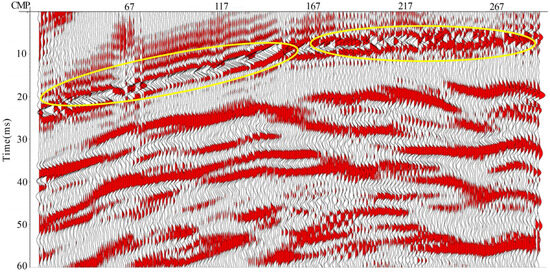
Figure 11.
High-resolution seismic profile of the inner city wall at the Baodun site.
In the corresponding seismic profile of the Xinjin Baodun site (Figure 12), the measured velocity of the soil layer is approximately 400 m/s, while that of the pebble layer is about 200 m/s, due to the density contrast between the pebble zone and the surrounding strata. Based on the data processing and analysis, and taking the seventh reflection point as an example, the time difference between the first arrival and the upper boundary of the pebble layer is 8.1 ms. According to the velocity–depth conversion, the calculated depth of this reflection point is 1.6 m, which corresponds well with the actual position of the pebble layer. Furthermore, the time difference between the upper and lower boundaries of the pebble layer is 10 ms, yielding a calculated thickness of approximately 1 m. This result also aligns with the observed characteristics of the pebble zone. These analytical findings support the accurate identification of the pebble layer’s position and distribution, enhancing the reliability of the seismic interpretation.
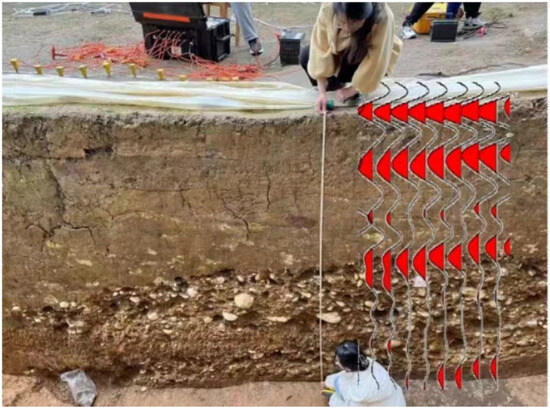
Figure 12.
Correspondence between the subsurface city wall structure and seismic wave reflections.
4. Discussion and Conclusions
- (1)
- In response to the complex seismogeological conditions of the western city wall at the Baodun site, this study systematically applied high-resolution seismic detecting techniques in combination with controllable high-frequency source excitation. A data acquisition system featuring high fold coverage and short offset distances was specifically designed to improve both the signal-to-noise ratio and the spatial resolution of the seismic dataset. By optimizing source excitation energy, the length of the receiver spread, and the geophone installation method, with particular emphasis placed on the influence of shallow pebble layer thickness, high-quality raw seismic data were acquired, providing a robust data foundation for subsequent high-resolution analysis.
- (2)
- By purposefully selecting suitable processing methods and testing analysis parameters, this study employed a frequency decomposition approach to effectively distinguish the dominant frequency bands associated with the rammed earth and pebble layers. The results reveal that the dominant frequency band of the rammed earth layer is primarily concentrated in the low-frequency range of 0–25 Hz, whereas that of the pebble layer lies within the high-frequency range of 75–105 Hz. This divergence in frequency distribution reflects a fundamental difference in their physical properties.
- (3)
- Through the extraction and comparative analysis of energy curves, this study applied the short-time Fourier transform (STFT) to obtain amplitude spectra at different time-window positions. The spectral peak amplitude was used as an indicator of seismic energy to reveal the temporal evolution of energy characteristics in the seismic data. The energy curve analysis indicates that the energy of the rammed earth layer is primarily concentrated in the low-frequency range, reflecting its relatively homogeneous and compact structure, which facilitates the propagation of low-frequency seismic waves. In contrast, the energy curve of the pebble layer exhibits significant fluctuations in the high-frequency band, suggesting that its heterogeneous structure enhances the scattering and reflection of high-frequency seismic waves, leading to uneven energy distribution and pronounced high-frequency responses.
- (4)
- When seismic waves propagate across stratigraphic interfaces, phenomena such as reflection, refraction, and transmission occur due to impedance contrasts between adjacent layers. In identifying the boundary between the rammed earth layer and the pebble layer, significant contrasts in density and wave velocity lead to pronounced phase changes as seismic waves cross the interface. This study leverages this property to precisely delineate the interface position, thereby providing a reliable basis for identifying discontinuous stratigraphic units.
- (5)
- Through high-frequency seismic data acquisition, combined with specialized processing and interpretive analysis, the identification of the rammed earth layer and the pebble layer was successfully achieved, and the anomalous zones corresponding to the pebble layer response were clearly delineated. This high-frequency seismic approach overcomes the limitations of traditional geophysical methods in detecting pebble layers within shallow and complex subsurface environments, and demonstrates its effectiveness under such challenging conditions. These results not only provide essential technical support for the archaeological excavation and preservation of the Baodun city wall site, but also—by virtue of their non-destructive nature, high efficiency, and high precision—establish a new methodological paradigm for the detection of pebble layers in prehistoric settlement sites, with significant potential for broader application and dissemination.
- (6)
- To further enhance the universality and detection accuracy of the technique, future research may proceed from the perspectives of multi-method integration, intelligent data processing, and interdisciplinary collaboration. By incorporating ground-penetrating radar (GPR) or electrical resistivity tomography (ERT), the limitations of single-method approaches under high-moisture or deep subsurface conditions can be effectively addressed. The adoption of machine learning algorithms, such as deep learning, may facilitate the automated identification of stratigraphic features in seismic data, thereby reducing interpretation errors stemming from human subjectivity. In addition, the integration of micromorphological and spectrochemical analyses has the potential to reconstruct past human–environment interactions from multiple perspectives—for instance, by revealing the provenance characteristics of the pebble layer and its possible association with paleo-river dynamics.
Author Contributions
Conceptualization, L.J. and Q.W.; methodology, L.J. and Q.W.; software, L.J. and Y.W.; Validation, J.W., T.B. and M.T.; formal analysis, Y.W., J.W. and T.B.; investigation, L.J., Y.W. and J.W., resources, Q.W., T.B. and M.T.; data curation, L.J., Y.W. and J.W.; writing—original draft preparation, L.J.; writing—review and editing, L.J. and Q.W.; visualization, L.J., Y.W. and J.W.; supervision, Q.W. and M.T.; project administration, Q.W.; funding acquisition, Q.W. All authors have read and agreed to the published version of the manuscript.
Funding
This study was supported by the International Science and Technology Innovation Co-operation of Sichuan Province (grant no. 2024YFHZ0238) and National Natural Science Foundation of Sichuan Province (grant no. 2023NSFSC0020).
Data Availability Statement
The data that have been used are confidential.
Acknowledgments
We gratefully acknowledge the financial support provided by Grant No. 2024YFHZ0238 from the International Science and Technology Innovation Cooperation Program of Sichuan Province, and Grant No. 2023NSFSC0020 from the National Natural Science Foundation of Sichuan Province, China. We would also like to thank the anonymous reviewers for their valuable comments and suggestions, which helped to improve the quality of this paper.
Conflicts of Interest
We declare that we have no financial or personal relationships with other people or organizations that could have inappropriately influenced our work.
References
- Jiang, Z.H.; Zhang, Q.; Wang, Y.; Jiang, C.; Lu, D.; Li, Y.F. A brief report on the 1996 excavation at the Baodun site in Xinjin County, Sichuan. Kaogu (Archeology) 1998, 1, 29–50+100. [Google Scholar]
- Jiang, Z.H.; Jiang, M.; He, K.Y.; Yan, B.; Jiang, S.L.; He, Q.; Li, P.; Li, Y.C.; Yan, B.; Chen, Y.J.; et al. Survey and preliminary excavation report of the Baodun site in Xinjin (2009–2010). Chengdu Kaogu Faxian (Chengdu Archaeol. Discov.) 2009, 1–67. [Google Scholar]
- Jiang, Z.H.; He, K.Y.; Zuo, Z.Q.; Li, P.; Chen, G.Y.; Yang, Y.P.; Wei, L.G.; Li, F.X.; Zeng, L.; Bai, T.Y.; et al. Archaeological excavation report of the Baodun site in Xinjin County (2012–2013). Chengdu Kaogu Faxian (Chengdu Archaeol. Discov.) 2014, 14–39. [Google Scholar]
- Jiang, C.; Yan, J.S. Survey and trial excavation of the Gucheng site in Pi County, Sichuan Province. Wenwu (Cult. Relics) 1999, 1, 32–42. [Google Scholar]
- Yan, J.S.; Chen, Y.H.; Tang, Z.H.; Jiang, S.L.; Dai, Z.M.; Chen, P.; Cheng, Y.F.; Dang, G.S.; Dang, G.P. Archaeological Excavation Results of the Ancient City Site in Pixian County, Sichuan Province, 1998–1999. Chengdu Kaogu Faxian (Chengdu Archaeol. Discov.) 1999, 29–39+320. [Google Scholar]
- Li, M.B.; Chen, Y.H. The 1999 excavation of the Yufu Village site in Wenjiang County. Chengdu Kaogu Faxian (Chengdu Archaeol. Discov.) 1999, 40–53. [Google Scholar]
- Wang, Y.; Kudō, M.; Ma, J.X.; Jiang, C.; Jiang, Z.H.; Lu, D.; Zhang, Q.; Fu, X.B.; Ni, L.Z.; He, Q.; et al. Brief report on the 1998 excavation at the Mangcheng site in Dujiangyan City. Chengdu Kaogu Faxian (Chengdu Archaeol. Discov.) 1999, 54–98. [Google Scholar]
- Wang, Y.; Kudō, M.; Ma, J.X.; Jiang, C.; Jiang, Z.H.; Mao, Q.X.; Yan, J.S.; Zhang, Q.; Xu, L.; Fu, X.B.; et al. A Brief Report on the 1999 Excavation of the Mangcheng Site in Dujiangyan City. Chengdu Kaogu Faxian (Chengdu Archaeol. Discov.) 1999, 99–126. [Google Scholar]
- Yan, J.S.; Jiang, Z.H.; Fan, T.Y. Survey and trial excavation of the Mangcheng site in Dujiangyan City, Sichuan. Kaogu (Archeology) 1999, 7, 14–27. [Google Scholar]
- Jiang, C.; Li, M.B. Brief report on the trial excavation of the Shuanghe prehistoric walled site in Chongzhou, Sichuan. Kaogu (Archeology) 2002, 11, 3–19+97+1. [Google Scholar]
- Zhong, Y.L.; Chen, J.; Liu, X.Y.; Zhou, Z.Q.; Bai, T.Y. Survey and trial excavation report of the Zizhu ancient city in Chongzhou. Chengdu Kaogu Faxian (Chengdu Archaeol. Discov.) 2014, 40–57+514–516. [Google Scholar]
- Liu, Y.M.; Wang, J.; Cheng, Y.F.; Li, Y.C.; Liu, X.Y.; Liao, X.B.; Zhu, Y.; Ji, W.; Yang, Y.; Cao, G.M.; et al. Brief report on the 2013 excavation of the Yandian ancient city site in Dayi County. Chengdu Kaogu Faxian (Chengdu Archaeol. Discov.) 2013, 45–65. [Google Scholar]
- Zhou, Z.Q.; Chen, J.; Li, J.; Lian, J.R.; Cai, Y.M.; Sun, C.; Liao, X.B.; Zhong, Y.L.; Yan, B.; Zuo, Z.Q.; et al. Brief report on the 2012–2013 survey and trial excavation of the Gaoshan ancient city site in Dayi County. Chengdu Kaogu Faxian (Chengdu Archaeol. Discov.) 2013, 1–4+681+5–44. [Google Scholar]
- Li, Z.M. Translation, from Academic Terminology to Exhibition Narrative: A Case Study of Baodun Museum. Chin. Mus. 2024, 5, 42–52. [Google Scholar]
- Huang, M. Prehistoric floods and water control documented at the archaeological sites in the Chengdu Plain. J. Earth Environ. 2024, 15, 193–206. [Google Scholar]
- Yang, L.H. A study of pebble remains at Baodun cultural sites in the Chengdu Plain. Zhonghua Wenhua Luntan (Forum Chin. Cult.) 2018, 3, 38–45. [Google Scholar]
- Yan, J.S.; Jiang, Z.H.; Zhang, Q.; Chen, Y.H. Brief report on the 1997 excavation of the Gucheng site in Pi County, Sichuan Province. Wenwu (Cult. Relics) 2001, 3, 52–68+1. [Google Scholar]
- Li, W.Q.; Huo, M.L.; Tian, X.L.; Fang, S.T. Application of microtremor detection technology based on SPAC method in subway engineering in water-rich sand pebble layer. Constr. Technol. (Chin. Engl. Ed.) 2023, 52, 55–62+75. [Google Scholar]
- Luo, L.; Wang, X.; Guo, H. Transitioning from remote sensing archaeology to space archaeology: Towards a paradigm shift. Remote Sens. Environ. 2024, 308, 114200. [Google Scholar] [CrossRef]
- Yao, Y.; Wang, X.; Luo, L.; Wan, H.; Ren, H. An overview of GIS-RS applications for archaeological and cultural heritage under the DBAR-heritage mission. Remote Sens. 2023, 15, 5766. [Google Scholar] [CrossRef]
- Qian, J.X. Remote sensing archaeology study on the Toqqouz Sarai City site in Xinjiang. J. Natl. Mus. China 2024, 5, 79–90. [Google Scholar]
- Wang, X.Y.; Luo, L. From remote sensing archaeology to space archaeology: A new task in the era of cultural heritage protection. J. Remote Sens. 2020, 24, 837–841. [Google Scholar]
- Tian, J.; Zhu, Y.C.; Li, L.Z.; Zhu, X.; Li, W.R.; An, X.L. Research on the prediction model of Neolithic archaeological sites based on GIS and XGBoost algorithm. J. Beijing Norm. Univ. (Nat. Sci.) 2025, 61, 1–15. [Google Scholar]
- Zhang, Y.X.; Wang, N.Y.; Zhang, X. Identification of archaeological sites based on CORONA stereo image pairs. Nanfang Wenwu (Cult. Relics South. China) 2024, 3, 257–265. [Google Scholar]
- Qian, J.X. The Practice of Drones Photography in the Archaeological Research of Earthen Mound Tombs in Southern Anhui. Southeast Cult. 2021, 5, 123–132. [Google Scholar]
- Tian, S.L.; Qin, G.M.; Qiao, B.T.; Wang, W.; Xian, Y.H.; Yu, C. Spatial archaeological surface survey method in complex occurrence environment supported by airborne LiDAR. J. Northwest Univ. (Nat. Sci. Ed.) 2025, 55, 139–149. [Google Scholar]
- Chen, M.H.; Ji, X.; Chen, Q.H.; Zhang, N.Z.; Zhang, Y.X.; Wang, Y.Y. Brief report on the 2020–2021 excavation of Liangzhu remains at the Beicun South locus of the Beicun site in Yuhang District, Hangzhou City. Kaogu (Archeology) 2024, 6, 3–18+121+2. [Google Scholar]
- Xu, D.Y.; Ran, H.L. Brief report on the 2022–2023 excavation at the Zhenwu Palace locus of the Sanxingdui site in Guanghan City, Sichuan. Sichuan Wenwu (Sichuan Cult. Relics) 2025, 2, 20–42+2+121. [Google Scholar]
- Hu, Y. Research on Partial Structure Extraction and Segmentation of Terracotta Warrior 3D Model Based on Deep Learning Method. Ph.D. Thesis, Northwest University, Xi’an, China, 2022. [Google Scholar]
- Zhou, M.Q.; Chu, T.; Geng, G.H.; Yao, W.M.; Zhang, J.; Cao, X. Three-dimensional cultural relic hole repair method combining structure and texture. Opto-Precis. Eng. 2022, 30, 894–907. [Google Scholar] [CrossRef]
- Yan, S. Research on Terracotta Warriors Face Recognition and Classification Based on Deep Learning. Ph.D. Thesis, Beijing University of Civil Engineering and Architecture, Beijing, China, 2024. [Google Scholar]
- Zhang, H.W.; Bao, Y.Y.; Zhang, R.; Meng, B.L.; Cai, Y.J.; Cheng, H. Characteristics and formation mechanism of stalagmite laminae in E’mei Cave, Jiangxi Province, China. Quat. Res. 2022, 42, 1148–1158. [Google Scholar]
- Chen, J.; Qiu, Y. Archaeological studies of prehistoric walled sites in the Chengdu Plain: Review and prospects. Zhongguo Wenhua Yichan (China Cult. Herit.) 2015, 6, 14–25. [Google Scholar]
- Xia, Y.; Ma, Q.; Zhang, Z.; Liu, Z.; Fang, J.; Shao, A.; Wang, W.; Fu, Q. Development of Chinese barium copper silicate pigments during the Qin Empire based on Raman and polarized light microscopy studies. J. Archaeol. Sci. 2014, 49, 500–509. [Google Scholar] [CrossRef]
- Ji, J.; Tan, P.P.; Yang, J.C. SEM-EDS analysis of manufacturing techniques of gold artifacts from the pre-Qin to Han dynasty. China Cult. Relics Sci. Technol. Res. 2022, 1, 64–71. [Google Scholar]
- Wu, J.T. Application of micro-area line scanning and surface scanning analysis technology in cultural relic conservation and scientific archaeology. Dongfang Shoucang (Orient. Collect.) 2024, 9, 58–61. [Google Scholar]
- Lü, Q.Q.; Wu, Y. LA-ICP-MS analysis of corroded glass beads from Southern China: Tackling highly inhomogeneous archaeological glass. STAR Sci. Technol. Archaeol. Res. 2019, 5, 53–63. [Google Scholar] [CrossRef]
- Guo, X.Q.; Sun, X.F.; Yi, S.W.; Wang, S.J.; Li, Y.H.; Wang, Y.H.; Zhou, Y.D. Age and environment of the Mandelashan lithic site in central Inner Mongolia. Acta Anthropol. Sin. 2025, 1–12. [Google Scholar]
- Lü, Y.; Zhang, J.P.; Tang, M.; Yang, Z.F.; Huang, M.; Jiang, M.; Min, X.; Shao, K.L.; Wen, C.H.; Ye, M.L.; et al. Phytolith analysis reveals the agricultural development and environmental background of the pre-Qin period in Chengdu Plain—A case study of Baodun and Sanxingcun sites. Quat. Res. 2021, 41, 1475–1488. [Google Scholar]
- Li, N.; He, J.N.; Lei, X.S.; Zhong, J.R.; Wu, X.H.; Yang, Y.L.; Pan, Y. Hierarchical structure and spatial variation: Stable isotopic analysis of Western Zhou-dynasty human remains from the Zhouyuan site. Kaogu Yu Wenwu (Archaeol. Cult. Relics) 2023, 6, 117–124. [Google Scholar]
- Ma, X.Z.; Yang, L.W.; Niu, S.R.; Zhong, J. Application of geophysical exploration technology in archaeological survey: A case study of the Qicheng site, Puyang, Henan Province. Zhongyuan Wenwu (Cult. Relics Cent. China) 2017, 2, 92–99. [Google Scholar]
- Liu, H.P.; Wang, S.; Liu, X.D.; Song, F.Z.; Zhang, Z. Application of comprehensive geophysical exploration in the archaeology of hidden pit outside Baling Mausoleum. Shaanxi Geol. 2022, 40, 94–97. [Google Scholar]
- Yang, H.; Zou, J.; Cheng, D.D.; Yu, J.L. Application of ground-penetrating radar in detecting the internal structures of the ancient Great Wall in Linhai City. Geophys. Geochem. Explor. 2024, 48, 1741–1746. [Google Scholar]
- Suo, R.Y. Design and implementation of archaeology excavation information system based on 3D WebGIS. Mod. Surv. Mapp. 2024, 47, 62–69. [Google Scholar]
- Li, Z.; Li, M.S.; Li, Y. Study on the early warning scene of beacon fire on the Ming Great Wall based on auxiliary beacon digital archaeological survey. Aerosp. Recovery Remote Sens. 2023, 44, 1–12. [Google Scholar]
- Bai, Y.F. Application of Photoscan Multi-View 3D Reconstruction Technology in the Protection of Earthen Sites. Ph.D. Thesis, Northwest University, Xi’an, China, 2017. [Google Scholar]
- Abudeif, A.M.; Abdel Aal, G.Z.; Abdelbaky, N.F.; Abdel Gowad, A.M.; Mohammed, M.A. Evaluation of engineering site and subsurface structures using seismic refraction tomography: A case study of Abydos.site, Sohag governorate, Egypt. Appl. Sci. 2023, 13, 2745. [Google Scholar] [CrossRef]
- Selim, E.I.; Basheer, A.A.; Elqady, G.; Hafez, M.A. Shallow seismic refraction, two-dimensional electrical resistivity imaging, and ground penetrating radar for imaging the ancient monuments at the western shore of Old Luxor city, Egypt. Archaeol. Discov. 2014, 2, 31–43. [Google Scholar] [CrossRef]
- Martorana, R.; Capizzi, P.; Pisciotta, A.; Scudero, S.; Bottari, C. An overview of geophysical techniques and their potential suitability for archaeological studies. Heritage 2023, 6, 2886–2927. [Google Scholar] [CrossRef]
- El-khteeb, A.; Mabrouk, W.M.; Soliman, K.S.; EL Aguizy, O.M.; Metwally, A. Archeological exploration via integrated shallow geophysical methods: Case study from Saqqara, Giza, Egypt. npj Herit. Sci. 2025, 13, 38. [Google Scholar] [CrossRef]
- Trebsche, P.; Schlögel, I.; Flores-Orozco, A. Combining geophysical prospection and core drilling: Reconstruction of a Late Bronze Age copper mine at Prigglitz-Gasteil in the Eastern Alps (Austria). Archaeol. Prospect. 2022, 29, 557–577. [Google Scholar] [CrossRef]
- Schwellenbach, I.; Hinzen, K.G.; Petersen, G.M.; Bottari, C. Combined use of refraction seismic, MASW; and ambient noise array measurements to determine the near-surface velocity structure in the Selinunte Archaeological Park, SW Sicily. J. Seismol. 2020, 24, 753–776. [Google Scholar] [CrossRef]
- Allen, M.D.; Stewart, R.R. Seismic and radar tomography of a Maya pyramid ruin. CREWES Res. Rep. 2008, 20, 2008-55. [Google Scholar]
- Shin, Y.H.; Shin, S.Y.; Rastiveis, H.; Cheng, Y.T.; Zhou, T.; Liu, J.; Habib, A. UAV-based remote sensing for detection and visualization of partially-exposed underground structures in complex archaeological sites. Remote Sens. 2023, 15, 1876. [Google Scholar] [CrossRef]
- Sylaiou, S.; Tsifodimou, Z.E.; Evangelidis, K.; Stamou, A.; Tavantzis, I.; Skondras, A.; Stylianidis, E. Redefining Archaeological Research: Digital Tools, Challenges, and Integration in Advancing Methods. Appl. Sci. 2025, 15, 2495. [Google Scholar] [CrossRef]
- Jenkins, E.; Galbraith, J.; Paltseva, A. Portable X-Ray Fluorescence as a Tool for Urban Soil Contamination Analysis: Accuracy, Precision, and Practicality. EGUsphere 2024, 1–26. [Google Scholar]
- Capozzoli, L.; Giampaolo, V.; De Martino, G.; Perciante, F.; Lapenna, V.; Rizzo, E. ERT and GPR prospecting applied to unsaturated and subwater analogue archaeological site in a full scale laboratory. Appl. Sci. 2022, 12, 1126. [Google Scholar] [CrossRef]
- Klanica, R.; Křivánek, R.; Grison, H.; Tábořík, P.; Šteffl, J. Capabilities and limitations of electrical resistivity tomography for map** and surveying hillfort fortifications. Archaeol. Prospect. 2022, 29, 401–416. [Google Scholar] [CrossRef]
- Plekhov, D.; Gosner, L.R.; Smith, A.J.; Nowlin, J. Applications of satellite remote sensing for archaeological survey: A case study from the Sinis Archaeological Project, Sardinia. Adv. Archaeol. Pract. 2020, 8, 192–205. [Google Scholar] [CrossRef]
- Inomata, T. Lidar, Space, and Time in Archaeology: Promises and Challenges. Annu. Rev. Anthropol. 2024, 53, 75–92. [Google Scholar] [CrossRef]
- Huang, M.; Ma, C.M.; He, K.Y.; Tang, M.; Xu, J.J.; Zhu, C. Environmental changes and human activities recorded by the pollen in the middle–late Holocene at Baodun site, Chengdu Plain. Quat. Res. 2022, 42, 1078–1093. [Google Scholar]
- Ye, Q. Prehistoric walled sites in the Chengdu Plain. Wenwu Jianding Yu Jiashang (Cult. Relics Apprais. Apprec.) 2020, 20, 155–157. [Google Scholar]
- Moustafa, S.S.R.; Mohamed, G.E.A.; Elhadidy, M.S.; Abdalzaher, M.S. Machine learning regression implementation for high-frequency seismic wave attenuation estimation in the Aswan Reservoir area, Egypt. Environ. Earth Sci. 2023, 82, 307. [Google Scholar] [CrossRef]
- Xue, Y.; Cao, J.; Wang, X.; Li, Y.; Du, J. Recent developments in local wave decomposition methods for understanding seismic data: Application to seismic interpretation. Surv. Geophys. 2019, 40, 1185–1210. [Google Scholar] [CrossRef]
- Guo, X.; Gao, J.; Yong, X.; Li, S.; Gui, J.; Wang, H. A novel high-resolution imaging method based on sparsity in the time domain and spectral fitting in the frequency domain. Front. Earth Sci. 2024, 12, 1247554. [Google Scholar] [CrossRef]
- Sun, L.; Zheng, X.; Ding, L.; Shou, H.; Li, H. Automatic Identification of Strong Energy Noise in Seismic Data Based on U-Net. IEEE Trans. Geosci. Remote Sens. 2023, 61, 1–11. [Google Scholar] [CrossRef]
- Zhang, H.B. Research and Application of Special High Precision Seismic Acquisition Method in Complex Surface Area. Ph.D. Thesis, Chengdu University of Technology, Chengdu, China, 2020. [Google Scholar]
- Duan, C.X.; Liang, Y.; Fan, X.H.; Zhang, F.C.; Wu, J. Research on high-resolution seismic data processing method based on adaptive VMD. CT Theory Appl. 2022, 31, 135–148. [Google Scholar]
- Dong, L.; Song, D.; Liu, G. Seismic wave propagation characteristics and their effects on the dynamic response of layered rock sites. Appl. Sci. 2022, 12, 758. [Google Scholar] [CrossRef]
- Hu, T.; Xu, B.; Wang, Y.; Zhu, J.; Zhou, J.; Wan, Z. Mine Microseismic Signal Denoising Based on a Deep Convolutional Autoencoder. Shock. Vib. 2023, 2023, 6225923. [Google Scholar] [CrossRef]
- Shenoi, B.A. Introduction to Digital Signal Processing and Filter Design; Wiley: Hoboken, NJ, USA, 2005. [Google Scholar]
- Jenitta, J.; Rajeswari, A. An Optimized Baseline Wander Removal Algorithm Based on Ensemble Empirical Mode De-composition. IAENG Int. J. Comput. Sci. 2015, 42. [Google Scholar]
- Tao, R.; Deng, B.; Zhang, W.Q.; Wang, Y. Sampling and sampling rate conversion of band limited signals in the fractional Fourier transform domain. IEEE Trans. Signal Process. 2007, 56, 158–171. [Google Scholar] [CrossRef]
- Bruni, V.; Tartaglione, M.; Vitulano, D. A pde-based analysis of the spectrogram image for instantaneous frequency estimation. Mathematics 2021, 9, 247. [Google Scholar] [CrossRef]
- Hsu, T.Y.; Liu, K.L. Onsite early prediction of peak amplitudes of ground motion using multi-scale STFT spectrogram. Earth Planets Space 2025, 77, 1–21. [Google Scholar] [CrossRef]
Disclaimer/Publisher’s Note: The statements, opinions and data contained in all publications are solely those of the individual author(s) and contributor(s) and not of MDPI and/or the editor(s). MDPI and/or the editor(s) disclaim responsibility for any injury to people or property resulting from any ideas, methods, instructions or products referred to in the content. |
© 2025 by the authors. Licensee MDPI, Basel, Switzerland. This article is an open access article distributed under the terms and conditions of the Creative Commons Attribution (CC BY) license (https://creativecommons.org/licenses/by/4.0/).